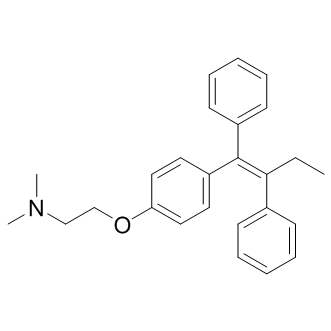| DC9022 |
Amifostine
|
Amifostine (WR2721) is a broad-spectrum cytoprotective agent and a radioprotector. Amifostine selectively protects normal tissues from damage caused by radiation and chemotherapy. Amifostine is potent hypoxia-inducible factor-α1 (HIF-α1) and p53 inducer. |
| DC9244 |
LX-1606
|
Telotristat ethyl (LX1606) is a novel, orally-delivered inhibitor of tryptophan hydroxylase that reduces serotonin production. |
| DC9243 |
LP533401 HCl
|
LP-533401 hydrochloride is a tryptophan hydroxylase 1 inhibitor that regulates serotonin production in the gut. |
| DCAPI1271 |
Ubenimex (Bestatin)
|
Bestatin is a natural, broad-spectrum, and competitive aminopeptidase inhibitor. |
| DC9096 |
Tamoxifen
|
Tamoxifen(ICI-46474) is an antagonist of the estrogen receptor in breast tissue via its active metabolite, hydroxytamoxifen. |
| DCAPI1371 |
Scopine HCl
|
Scopine hydrochloride (6,7-Epoxytropine hydrochloride) is the metabolite of anisodine, which is a α1-adrenergic receptor agonist and used in the treatment of acute circulatory shock. |
| DCAPI1251 |
Nitazoxanide (Alinia, Annita)
|
Nitazoxanide is a synthetic nitrothiazolyl-salicylamide derivative and an antiprotozoal agent. (IC50 for canine influenza virus ranges from 0.17 to 0.21 μM). |
| DCAPI1372 |
Ciprofloxacin (Cipro)
|
Ciprofloxacin (Bay-09867) is a fluoroquinolone antibiotic, exhibiting potent antibacterial activity. |
| DCAPI1390 |
Atovaquone (Atavaquone)
|
Atovaquone is a medication used to treat or prevent for pneumocystis pneumonia, toxoplasmosis, malaria, and babesia. |
| DCAPI1051 |
Arbidol HCl (Umifenovir)
|
Umifenovir is currently being investigated as a potential treatment and prophylactic agent for COVID-19 caused by SARS-CoV2 infections in combination with both currently available and investigational HIV therapies. Arbidol hydrochloride (Umifenovir hydroc |






















